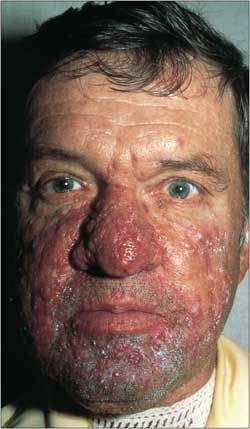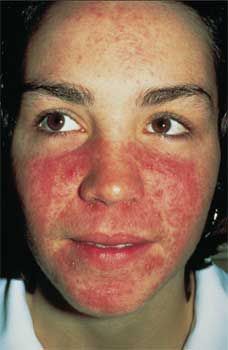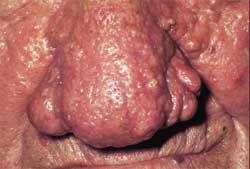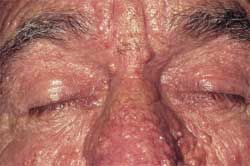- Clinical Technology
- Adult Immunization
- Hepatology
- Pediatric Immunization
- Screening
- Psychiatry
- Allergy
- Women's Health
- Cardiology
- Pediatrics
- Dermatology
- Endocrinology
- Pain Management
- Gastroenterology
- Infectious Disease
- Obesity Medicine
- Rheumatology
- Nephrology
- Neurology
- Pulmonology
Middle-aged Man Who Claims He Is Not a Drinker
A 41-year-old man is seen for routine physical examination. Apart from mildly elevated cholesterol 2 years ago and a bout of bacterial bronchitis last winter, he has been healthy. Says he has had “bad acne” since age 21. Has applied drying agents that worsened it and that sting; has “sensitive skin” problems from creams. Now prefers to ignore his facial skin.
This article was originally presented as an independent educational activity under the direction of CME LLC. The ability to receive CME credits has expired. The article is now presented here for your reference. CME LLC is no longer responsible for the presentation of the article.
HISTORY

A 41-year-old man is seen for routine physical examination. Apart from mildly elevated cholesterol 2 years ago and a bout of bacterial bronchitis last winter, he has been healthy. Says he has had “bad acne” since age 21. Has applied drying agents that worsened it and that sting; has “sensitive skin” problems from creams. Now prefers to ignore his facial skin.
PHYSICAL EXAMINATION
Moderately unkempt-appearing but well-spoken man. Vital signs normal. Face and skin as shown. No lesions seen elsewhere on skin or in mucous membranes of his mouth.
WHAT’S YOUR DIAGNOSIS?
What’sYour Diagnosis?
ANSWER: ROSACEA
This man’s red, papulopustular, inflamed central and lower face permit a diagnosis of rosacea,1 a condition of unknown cause that affects nose, cheeks, chin, and sometimes adjacent skin. His overgrown nose constitutes rhinophyma, a subtype of rosacea that chiefly afflicts men. There is no diagnostic test for rosacea, no pathognomonic feature, and even the histopathology on skin biopsy is not unique; so the diagnosis is made clinically, ideally long before rhinophyma can supervene.
The patient’s prominent beard stubble, along with the exposed mesh undershirt, and bits of white material on beard and cheeks, make an impression of carelessness about his appearance in public. We need to be wary of drawing such a conclusion: his uneven skin surface may make shaving painful or bloody, and the white debris could be something applied topically to relieve misery.
Minimal injection of the conjunctivae and some crusting of his lower eyelids could represent ophthalmic rosacea.
The forehead shows just a single papule and a suggestion of thickened skin. Scalp hair and eyebrows appear normal.
SUBTYPES I AND II

Figure 1 – In a young girl with corticosteroid-induced rosacea, central facial predilection is particularly prominent. Erythema is punctuated by papules, some topped by pustules that produce pinpoint white spots. Forehead shows what appears to be ordinary steroid acne, while eyes and periocular skin are spared.
Classification of rosacea brings order to a plethora of red faces and prominent blood vessels on the skin of the nose.1-5 After onset, often in early to mid-adulthood, progression can occur over decades.
Subtype I rosacea usually includes recurrent facial flushing and blushing, more severe than in the general population. For predisposed persons, alcohol triggers or worsens attacks. Inappropriate or excessive vasodilation of facial vessels is part of the problem, but the cause of this vasodilation is unclear. Recognized triggers vary from patient to patient: alcohol, emotional upset, excess sunlight, heat, hot drinks, foods, certain medicines, even menses.
A more fixed facial erythema may arise on its own, or persist between episodes of flushing. Facial telangiectases also begin to appear. Unfortunately, the topical medicines that strikingly ameliorate subtype II often accomplish nothing but to enhance irritation of the skin in this subtype, and many oral medicines are ineffective.1 Many but by no means all patients with subtype I go on to papules or papulopustules, constituting subtype II (Figure 1). Pores usually become more prominent over time.
Progressive grading of this subtype denotes progressive prominence: deeper erythema, facial swelling, and grouped telangiectases that are often mistaken for signs of alcoholism. They lack the “body” and radiating legs of actual spider angiomas; and spiders of course bespeak liver disease but by no means exclusively alcoholic in type.6
Papules and pustules may grow to nodule size, more than a centimeter across, and there can be plaque-like fixed edema of parts of the inflamed facial skin. Coarsening of features may produce a leonine appearance that may recall textbook photographs of leprosy and, to a lesser degree, acromegaly.
IS IT A TYPE OF ACNE?
Any labeling of the papulopustules as “pimples” worsens confusion with acne, as does the outdated name acne rosacea. Comedones-known by their lay names of blackheads and whiteheads to most of the public-will point to acne rather than to rosacea; onset in the teen years also strongly suggests acne.
WHERE DOES RHINOPHYMA FIT IN?

Figure 2 –A close-up view of a third person with rosacea shows striking hypertrophy of the nasal soft tissue constituting advanced rhinophyma. Adjacent portions of cheeks show extensive papule formation and surface irregularity from overgrowth of sebaceous tissue and connective tissue. A tiny venous lake is seen on the left lower lip.
Subtype III of rosacea is the one in which phymata occur: the most familiar is rhinophyma, whereby the nose shows irregular, grotesque overgrowth of soft tissue and sebaceous glands (Figures 2 and 3). Of course, not every bulbous nose constitutes rhinophyma, even in a person with rosacea. Wide ethnic variation in nose size and shape is exceeded by still wider individual variation independent of any disorder. Treatment now includes surgical and other reductive and ablative measures.
Other phymata, or growths of similar tissue, can occur on the forehead (metopophyma) and elsewhere. Usually rhinophyma accompanies advanced rosacea that has affected the entire midface, but occasionally it is the dominant manifestation.
Rhinophyma, of all rosacea manifestations, is the most likely to be mistaken for a beacon of alcohol abuse. Besides in medical texts and articles, it is strikingly depicted in a Renaissance Italian painting of a gentle old man speaking with a child, perhaps by Pollaiuolo, that adorns the cover of an old issue of Scientific American on medicine.7
ALCOHOL, SHAKESPEARE, PSYCHOSOCIAL ISSUE
Established rosacea will worsen with any vasodilator, including alcohol. This partly explains why rosacea and rhinophyma are more frequent in alcohol abusers, though of no predictive value for alcoholism. Unfortunately, the maximal prevalence of rosacea among Celtic northern Europeans plays into further prejudices about alcohol.1

Figure 3 –Upper face of this same patient reveals hypertrophy of forehead soft tissue that contrasts sharply with the other two illustrated patients.
Readers of Shakespeare’s wonderful Henriad plays8-10 may recall the stunning taunts against Bardolph, a hapless soldier and thief who associates with Sir John Falstaff. Bardolph himself calls his nose and its papules meteors because they are so incandescently red.8 Later Falstaff deems the nose a hellfire and says its use- perhaps the ultimate antecedent of the Rudolph the Red-Nosed Reindeer story-is to light the way: “Thou hast saved me a thousand marks in . . . torches, walking with thee in the night betwixt tavern and tavern; but the sack [sherry] that thou hast drunk me would have bought me lights as good cheap. . . .” His comments and accusations, full of wit and cruelty, hurt all the more because we feel Falstaff’s own alcoholism should make him more sensitive to the problem of another. Though the text suggests that all the company drank to excess, the humiliation of Bardolph is based on a false premise. The hostess of a tavern-brothel calls him “that arrant malmsey-nose knave, Bardolph,”9 though next to “mad mustachio purple-hued maltworms,”8 perhaps this is not the very worst appellation. His demotion from lieutenant to corporal is noted after the death of Falstaff, heartbroken by Henry V’s vicious public disavowal. Even a mere boy taunts Bardolph in asking him to serve as a warming pan because of the putative heat of his fiery nose.10 In the end Bardolph hangs, fulfilling the prediction made by a young Prince Hal.8
Four centuries later, we have not yet learned to cease inferring alcoholism from rosacea in general and rhinophyma in particular.
Even in conventional rosacea, the psychosocial aspects are formidable: the face that the patient shows to the world is disfigured, sometimes to a shocking degree. 5 Well-meaning advice about hygiene-which is no more the source of the problem than is alcohol-tends only to augment misery.
ROSACEA AND THE EYES
Ophthalmic rosacea (subtype IV) includes conjunctivitis and blepharitis and rarely involvement of uvea and cornea; the latter can jeopardize sight. Surprisingly, the intensity of eye problems need not parallel the severity of facial skin lesions.
Ophthalmic rosacea can be confused with seborrheic dermatitis having ophthalmic involvement. But greasy, yellow facial scale about the forehead and eyebrows will point to seborrheic dermatitis, and a red face to rosacea. Distinction can be difficult in a subset of cases.
INTERVENTIONS
A host of nonpharmacological measures and well-chosen prescribed therapies make all the difference, in contrast to the poor efficacy and high toxicity of products selected without consulting a medical professional. Even with established rhinophyma, cosmetic surgical approaches and other measures can often restore a facial appearance that the patient can be comfortable about displaying in public.
Effective choices from the topical and systemic pharmacological armamentarium do not usually need a dermatologist, but do require close consideration of both benefit and potential adverse effect, with utmost care about avoiding teratogenic products and those that can harm the teeth of fetus or child.
Schneiderman H. Rosacea from Shakespeare’s day to our own. CONSULTANT. 2009;49:382-386.
References:
REFERENCES:1. Powell FC. Clinical practice. Rosacea. N Engl J Med. 2005;352:793-803.
2. Tanzi EL, Weinberg JM. The ocular manifestations of rosacea. Cutis. 2001;68:112-114.
3. Rohrich RJ, Griffin JR, Adams WP Jr. Rhinophyma: review and update. Plast Reconstr Surg. 2002;110:860-869; quiz 870.
4. Lesclous P, Maman L. An unusual case of a relationship between rosacea and dental foci. Oral Surg Oral Med Oral Pathol Oral Radiol Endod. 1999;88:679-682.
5. Garnis-Jones S. Psychological aspects of rosacea. J Cutan Med Surg. June 1998;2(suppl 4):16-19.
6. Schneiderman H. Giant cutaneous vascular spider. Consultant. 2003;43:621-626.
7. White KL. Life and death and medicine. Sci Am. 1973;229(3):22-33.
8. Shakespeare William. The History of Henry IV [part I]. New York: Washington Square Press; 1961; edited by Louis B. Wright and Virginia A. LaMar (The Folger Library General Reader’s Shakespeare):II.iv.323-329; III.iii.25-53; II.i.74-75.
9. Shakespeare William. The Second Part of King Henry the Fourth. Rev ed. New York: Penguin Books; 1970; edited by Claire McEachern (The Pelican Shakespeare):II.1.37-38 and II.4.341-345.
10. Shakespeare William. The Life of King Henry the Fifth. New ed. New York: Penguin Books; 1999; edited by Claire McEachern (The Pelican Shakespeare), II.1.81-82.
